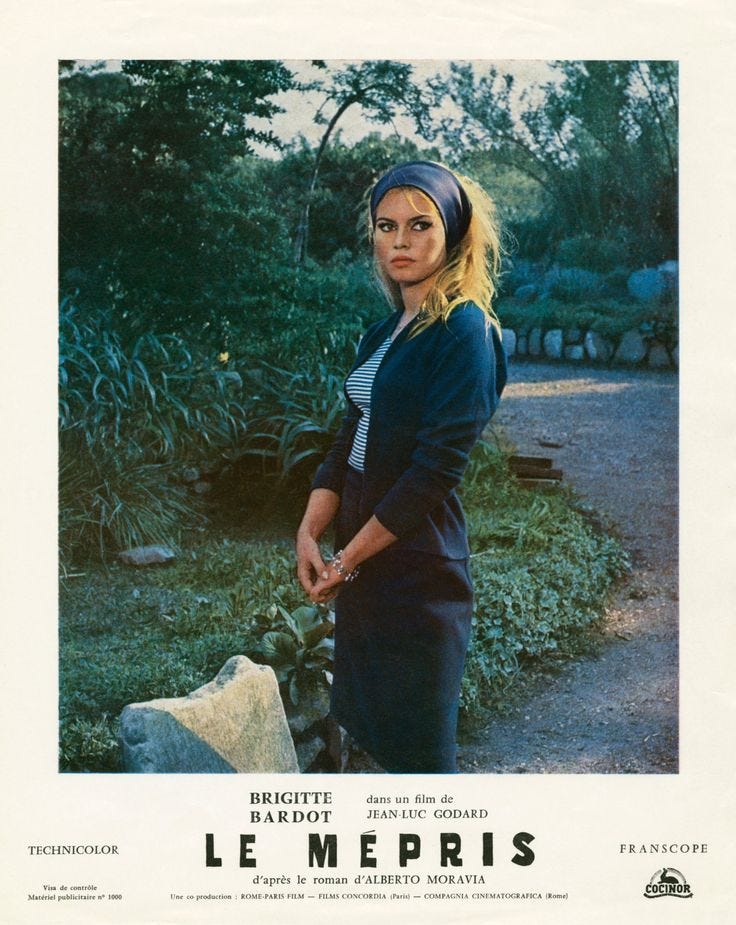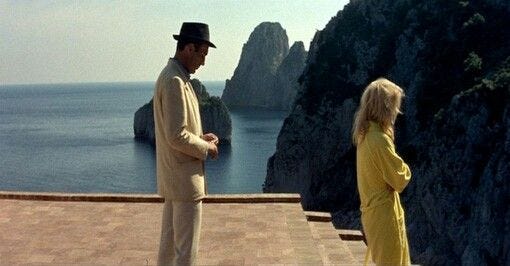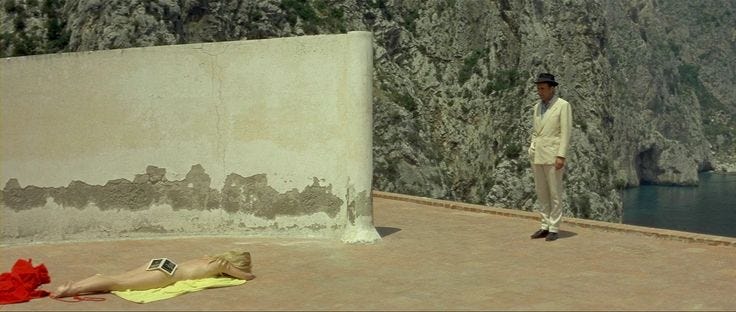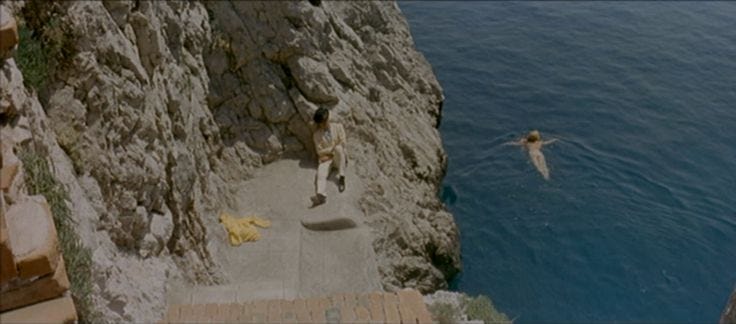Happy Sunday and welcome to Giselle daydreams! Today I’m writing about Le Mépris, an iconic film by Jean-Luc Goddard. This is my favourite film by Goddard, and I’m glad I could include it in my Summer cinema series. Before telling you more about the film itself, I wanted to briefly touch on the magnificent villa the film was shot.
Casa Malaparte, also known as Villa Malaparte, is a striking house located on Punta Massullo on the eastern side of the island of Capri, Italy. It is regarded as one of the finest examples of Italian modern and contemporary architecture. The initial design for the house was created around 1937 by renowned Italian architect Adalberto Libera for Curzio Malaparte. However, Malaparte ultimately rejected Libera's design and undertook the construction himself, with the assistance of Adolfo Amitrano, a local stonemason.
Le Mépris (Contempt in English) is a 1963 French film directed by Jean-Luc Godard, one of the leading figures of the French New Wave. This is a rich and multifaceted film that delves into themes of artistic integrity, personal disillusionment, and the complexities of human relationships. The film is also known for its exploration of personal and professional conflicts, its commentary on the nature of filmmaking, the clash between artistic integrity and commercialism, and its distinctive visual style.
The film follows Paul Javal, played by Michel Piccoli, a French screenwriter, who is hired to rewrite a script for an adaptation of Homer's The Odyssey directed by Fritz Lang (playing himself), who is a veteran director committed to his artistic vision. Paul is caught between artistic integrity and commercial demands. Lang is at odds with the brash and demanding American producer, Jeremy Prokosch, played by Jack Palance, who prioritises profit over artistry. As Paul becomes more involved with the project, tensions rise between him and his wife, Camille, played by Brigitte Bardot. This leads to a deepening sense of contempt between them, as the latter becomes increasingly disillusioned with their relationship. The narrative interweaves their personal conflicts with the broader theme of artistic compromise.
Le Mépris presents three iconic scenes. The first one is the opening scene when the film begins with a long tracking shot of Brigitte Bardot's naked body while she asks Paul if he loves various parts of her body. This scene sets the tone for the film's exploration of love, desire, and objectification, and highlights the superficial nature of their relationship. Another key scene includes a lengthy, continuous shot sequence in Paul and Camille’s apartment, which captures the growing distance and tension between them. The claustrophobic setting and lack of cuts heighten the sense of entrapment and alienation, reflecting their emotional disconnect. Ultimately, the final scenes, which can be referred to as the cliff sequence, set against the backdrop of the Mediterranean Sea underscore the themes of isolation and the inevitability of fate. The imagery evokes the mythic and tragic elements of The Odyssey, drawing parallels between the epic's themes and the characters' personal struggles.
The film delves into the tension between artistic integrity and commercial interests in the filmmaking industry. Fritz Lang represents the artistic integrity of cinema, striving to create a meaningful adaptation as well as preserving the essence of Homer’s The Odyssey, while Jeremy Prokosch embodies the commercial pressures that compromise artistic vision by prioritising profit and mass appeal over artistic merit. Paul's involvement in rewriting the script symbolises the struggle to maintain personal and artistic integrity while being forced to compromise to meet the producer's demands. This conflict reflects Godard's own concerns and critiques about the film industry and the compromises artists must make.
The film explores how communication, or the lack thereof, can erode relationships. Paul and Camille's marriage disintegrates due to their inability to understand each other and express their true feelings. Their conversations are filled with misunderstandings and unspoken emotions, highlighting how poor communication can lead to alienation and contempt. The film uses language and dialogue to show how characters fail to understand each other, leading to emotional distance. This theme is mirrored in the professional realm, where artistic visions are compromised by miscommunication and differing priorities between the director, writer, and producer.
Camille's growing contempt for Paul stems from a sense of betrayal and alienation. As Paul becomes more entangled with the commercial aspects of filmmaking, Camille feels increasingly neglected and misunderstood. This personal contempt parallels the broader theme of alienation in modern life and the creative process. Their personal conflict is a microcosm of the larger artistic and existential crises faced by the characters. The alienation theme extends to the filmmaking process, where creative individuals like Fritz Lang feel estranged from the commercialised vision imposed by producers like Prokosch.
Camille's character serves as a commentary on the objectification and limited roles available to women in both personal relationships and the film industry. The opening scene, where Camille asks Paul if he loves various parts of her body, sets the tone for the film's exploration of love, desire, and objectification. It also underscores her role as an object of desire rather than a person with her own agency. Camille's role oscillates between the object of desire and a person with her own agency, reflecting the limited and often contradictory roles available to women. Moreover, Camille's dissatisfaction and eventual contempt for Paul reflect a deeper critique of how women are treated and valued in both personal relationships and the broader societal context.
Le Mépris examines different facets of love, from physical desire (eros) to deeper emotional connection (agape). Camille and Paul's relationship starts with physical attraction but deteriorates as emotional and intellectual gaps widen. The shifting power dynamics in Paul and Camille's relationship reflect broader societal structures. Camille's increasing contempt and Paul's growing indifference highlight the imbalance and lack of mutual respect.
The film draws parallels between the epic journey of The Odyssey and the personal journeys of the characters. The themes of quest, struggle, and the search for meaning in The Odyssey are mirrored in the characters' lives. While The Odyssey represents heroic and epic themes, Le Mépris portrays modern disillusionment and the fragmentation of contemporary life, contrasting the grandeur of myth with the banality of modern existence.
Godard employs a striking visual style, using bold primary colours to convey emotional states and thematic contrasts. The cinematography by Raoul Coutard enhances the film's aesthetic impact, with carefully composed shots that reflect the characters' inner turmoil. The film employs Godard's signature jump cuts and unconventional narrative structure, which disrupt the flow and create a sense of dislocation. This technique reflects the characters' fragmented relationships and the broader disintegration of artistic integrity.
Le Mépris is deeply self-referential, with numerous allusions to film history and filmmaking itself. By casting Fritz Lang as himself and referencing other films and directors, Godard creates a meta-cinematic layer that invites viewers to reflect on the nature of cinema and storytelling. The film serves as a critique of Hollywood's influence on global cinema, emphasising the tension between European art cinema and American commercial cinema.
Le Mépris is considered one of Godard's masterpieces and a classic of French cinema. Its exploration of the film industry, complex character dynamics, and innovative style have influenced countless filmmakers and scholars. The film remains a critical text for understanding the conflicts between art and commerce and the personal and professional struggles within creative industries.
Le Mépris is a profound exploration of the nature of love, art, and the compromises inherent in both. The film also depicts the existential struggles faced by individuals in the modern world. Godard's innovative use of cinematic techniques, combined with his incisive commentary on the nature of filmmaking and personal alienation, makes Le Mépris a timeless and thought-provoking film. Godard's film continues to resonate for its bold visual style, its layered narrative, and its incisive commentary on the human condition. It stands as a testament to the enduring power of cinema to reflect and critique the world. The film's exploration of artistic integrity, personal disillusionment, and complexities of human relationships remains relevant, making it a timeless work of art.
I hope you enjoyed reading about Le Mépris, and let me know if you’ve watched it! In the meantime you read about Roman Holiday, La Dolce Vita, and L’Eclisse if you haven’t done so yet.
See you in 2 weeks to end the Summer with the last film of my cinema series featuring 5 movies filmed in Italy!
Giselle xx










Oh, I have "watch more Jean-Luc Goddard films" on my list but haven't seen Le Mepris! I'll have to tune-in soon.